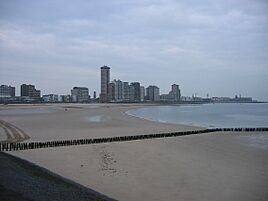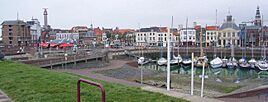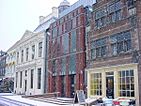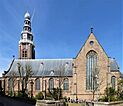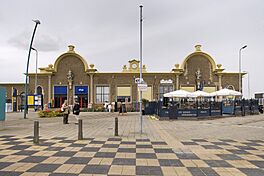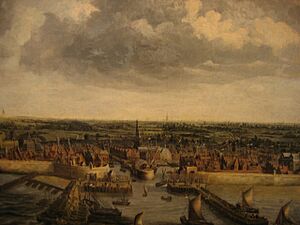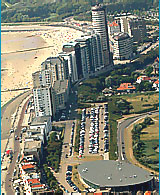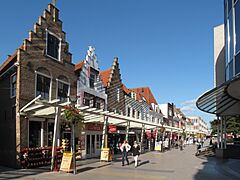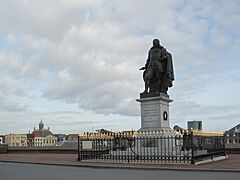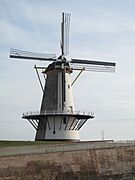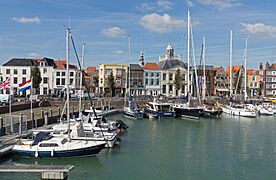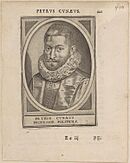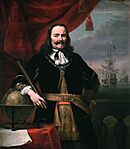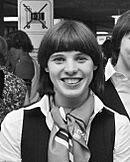Vlissingen facts for kids
Quick facts for kids
Vlissingen
Vlissienge (Zeeuws)
Flushing
|
|||
|---|---|---|---|
|
Boulevard with beach
Harbour
Zeeuws Maritiem muZEEum
St James the Great Church
Vlissingen Navy Drydock
Railway station
|
|||
|
|||
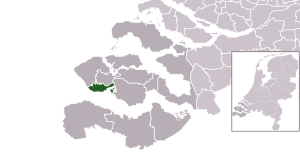
Location in Zeeland
|
|||
| Country | Netherlands | ||
| Province | Zeeland | ||
| Boroughs |
8 Districts
Binnenstad
Middengebied Paauwenburg-Westduin Lammerenburg Oost-Souburg Ritthem Binnen- en Buitenhavens Sloegebied |
||
| Government | |||
| • Body | Municipal council | ||
| Area | |||
| • Total | 344.83 km2 (133.14 sq mi) | ||
| • Land | 34.18 km2 (13.20 sq mi) | ||
| • Water | 310.65 km2 (119.94 sq mi) | ||
| Elevation | 1 m (3 ft) | ||
| Population
(May 2014)
|
|||
| • Total | 44,353 | ||
| • Density | 1,298/km2 (3,360/sq mi) | ||
| Demonym(s) | Vlissinger | ||
| Time zone | UTC+1 (CET) | ||
| • Summer (DST) | UTC+2 (CEST) | ||
| Postcode |
4380–4389
|
||
| Area code | 0118 | ||
Vlissingen (Dutch: [ˈvlɪsɪŋə(n)]), also known as Flushing in English, is a city in the southwestern Netherlands. It is located on the island of Walcheren. Vlissingen has been a very important harbor for hundreds of years. This is because of its great location between the Scheldt river and the North Sea.
The city was given special city rights in 1315. In the 1600s, Vlissingen's harbor was a main stop for ships of the Dutch East India Company. This company was very important for trade around the world. Vlissingen is also famous as the birthplace of Michiel de Ruyter. He was a very well-known Dutch admiral. Today, Vlissingen is mostly known for its shipyards. Many ships for the Royal Netherlands Navy are built there.
Contents
Places in Vlissingen
The area of Vlissingen includes the main city and a few smaller places:
- City: Vlissingen
- Villages: Oost-Souburg, Ritthem, and West-Souburg
- Hamlet: Groot-Abeele
A Look at Vlissingen's Past

Vlissingen started as a small fishing village around the year 620. It was located where the Schelde river meets the sea. Over 1,400 years, it grew into one of the most important ports in the Netherlands. The first harbors were dug by the rulers of Holland, Flanders, and Zeeland.
For centuries, Vlissingen was a busy place for fishing, especially for herring. It was also a center for trade and privateering. Privateering meant that ships were allowed by their government to attack enemy ships.
The first clear records of Vlissingen are from 1247. At that time, it already had a church and a hospital. In 1294, Floris V, Count of Holland bought the town. He saw how important its location was for trade and defense. He started to develop it further. In the mid-1400s, the port grew even more. This was helped by the city having a special right to control the herring trade.
In the mid-1500s, the city faced hard times. This was due to the Eighty Years' War, when the Dutch fought against Spanish rule. High taxes from the Duke of Alba made things worse. In April 1572, the people of Vlissingen rose up. They kicked out the soldiers and even hung a Spanish nobleman.
Later, in 1585, English soldiers were stationed in Vlissingen. This was to keep the port out of Spanish hands. The towns were sold back to the Dutch in 1616. During the Dutch Golden Age, ships from Vlissingen sailed to many parts of the Dutch colonial empire. This helped the Dutch Republic become a world power.
Vlissingen's history also includes invasions and bombardments. Because it is at the mouth of the Schelde river, it was very important for controlling access to Antwerp. This made it a target for the British, French, Germans, and Spanish. Floods were also a constant danger.
The city declined in the 1700s, especially during the Napoleonic Wars. But after 1870, things got better. New docks were built, a canal was dug, and the railway arrived. The De Schelde shipyard also opened.
World War II stopped this growth. The city was badly damaged by bombs and floods. But British soldiers liberated it on November 3, 1944. After the war, the city was rebuilt. In the 1960s, a new port and industrial area called Vlissingen-Oost grew. This area is now a major economic center for Zeeland. It provides thousands of jobs. Today, about 50,000 ships from all over the world pass through the Schelde each year.
What's in a Name?
The Name "Vlissingen"
It's not totally clear where the name Vlissingen comes from. Most experts think it has something to do with the word fles, which means "bottle."
One story says that in the 600s, a saint named Willibrord came to Vlissingen. He shared the contents of a bottle with beggars. A miracle happened, and the bottle never emptied! When the beggars didn't listen to his words, he gave them the bottle. He then supposedly called the city Flessinghe.
Another idea is that the name came from an old ferry house. This house had a bottle as a sign. A monk visiting in 967 supposedly called it "the ferry at the Bottle." Over time, as many cities in the region added -inge to their names, it became Vles-inge.
Some also believe the name comes from the Danish word Vles, meaning "tides."
A place far away, Cape Flissingsky in Novaya Zemlya, was named after Vlissingen in 1596 by explorer Willem Barentsz.
Why it's called "Flushing" in English
Vlissingen was historically known as "Flushing" in English. In the 1600s, Vlissingen was so important that English speakers gave it their own name. For example, Samuel Pepys wrote about "Flushing" in his famous diaries.
The American town of Flushing in New York City was first a Dutch village. It was founded in 1645 and named Vlissingen after the city in the Netherlands. English settlers later shortened the name to "Flushing." This change happened even before the English took over the area. This village is also famous for the Flushing Remonstrance, an early call for religious freedom.
There's also a village called Flushing in Cornwall, England. It was named by Dutch engineers from Vlissingen who helped build its main docks. Other towns called Flushing can be found in Michigan and Ohio in the US.
Gallery
-
Windmill: de Oranjemolen
Vlissingen's Climate
Vlissingen has a mild oceanic climate. This means it has cool summers and mild winters. It is warmer than other parts of the Netherlands. This is because it is located further south on the coast. It gets about 180 more hours of sunshine each year than Maastricht. The hottest temperature ever recorded was 37.3°C in July 2018. The coldest was -18.9°C in February 1956.
Famous People from Vlissingen
Many interesting people have come from Vlissingen:
Artists and Writers
- Petrus Cunaeus (1586–1638), a Dutch scholar who wrote The Hebrew Republic.
- Adriaan Dortsman (1635–1682), a famous Dutch architect from Amsterdam.
- Betje Wolff (1738–1804), a well-known Dutch novelist.
- Jacobus Bellamy (1757–1786), a Dutch poet.
- Fred Florusse (1938–2023), a Dutch actor and comedian.
Scientists
- Martin Kalbfleisch (1804–1873), a Dutch pioneer in the chemical industry. He also became a politician in the US.
- Egbert Cornelis Nicolaas van Hoepen (1884–1966), a paleontologist from South Africa who was born in the Netherlands.
- Maarten de Rijke (born 1961), a Dutch computer scientist.
Important Admirals
- Joos de Moor (1548 or 1558 – 1618), a Dutch Vice Admiral.
- Johan Evertsen (1600–1666), a Dutch admiral.
- Michiel de Ruyter (1607–1676), a very famous Dutch admiral.
- Cornelis Evertsen the Elder (1610–1666), another important Dutch admiral.
Other Explorers and Travelers
- Willem Verstegen (c.1612–1659), a merchant for the Dutch East India Company.
- Nicholas van Hoorn (c.1635–1683), a merchant sailor and privateer.
- Samuel van der Putte (1690–1745), a Dutch explorer who traveled a lot in Asia.
Sports Stars
- Joris Tjebbes (1929–2001), a Dutch swimmer who competed in the 1952 Olympics.
- Els Vader (1959–2021), a Dutch sprinter who competed in the Olympics.
- Danny Blind (born 1961), a famous former Dutch international football player.
- Lex Veldhuis (born 1983), a professional poker player.
Getting Around Vlissingen
- Train Stations: You can travel by train from Vlissingen and Vlissingen Souburg.
- Ferry: There is a ferry that connects Vlissingen to Breskens. Since 2003, when the Western Scheldt Tunnel opened, this ferry is only for people walking or riding bikes.
- There used to be a ferry service to Sheerness in England, but it stopped in 1994.
See also
 In Spanish: Flesinga para niños
In Spanish: Flesinga para niños


